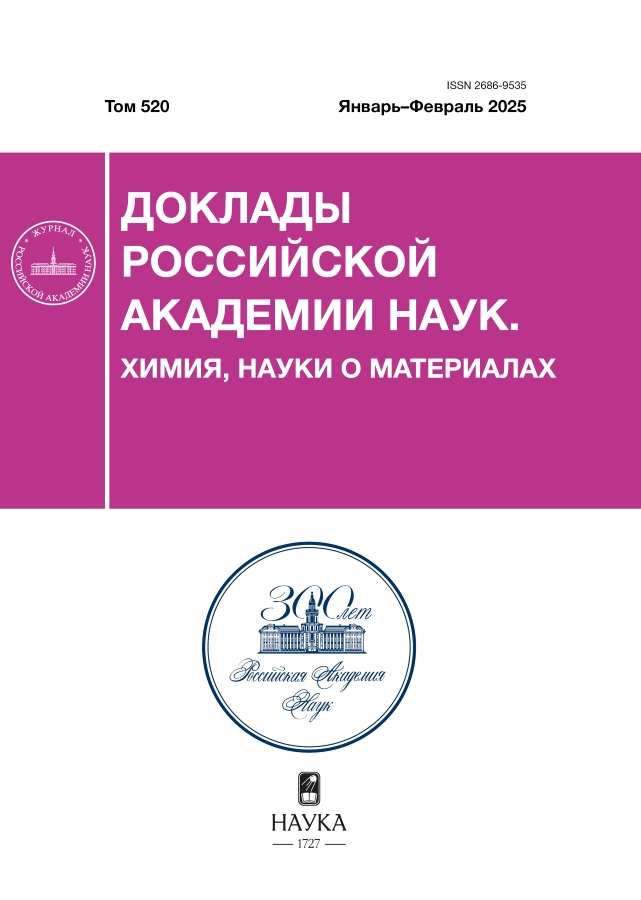Impact resistance of epoxy composites of reduced flammability with organobentonite nanoparticles
- Autores: Yevtushenko Y.M.1, Toirov S.K.1, Aleksandrov A.I.1, Shevchenko V.G.1
-
Afiliações:
- N.S. Enikolopov Institute of Synthetic Polymer Materials of the Russian Academy of Sciences
- Edição: Volume 520, Nº 1 (2025)
- Páginas: 60-64
- Seção: PHYSICAL CHEMISTRY
- URL: https://edgccjournal.org/2686-9535/article/view/683268
- DOI: https://doi.org/10.31857/S2686953525010077
- EDN: https://elibrary.ru/AVXQWD
- ID: 683268
Citar
Texto integral
Resumo
For the first time, the maximum synergistic effect of reducing the flammability of epoxy resin according to the oxygen index was established using a non-stoichiometric mixture of melamine and ammonium hydrophosphate. The synergetics of the mixture is due to the formation of heat-resistant ceramic-like structures as a result of thermal degradation of the components. In the present work, the effect of increasing the resistance up to (80 ± 10)% to impulse loads followed by rapid failure (mechanical or rheological explosion) was established for the first time for a polymer composite based on cured epoxy resin with 20% content of phosphorus-nitrogen-containing flame retardants (P,N-antipyrenes) due to the introduction of 0.5–1.5% organobentonite nanoparticles. It is also recorded that the electric current pulses arising from the ultrafast destruction of the “matrix” composite differ in frequency characteristics from the composite with the introduced nanoparticles of organobentonite. For a polymeric composite, one band of radio frequency radiation with a maximum at 2.4 MHz is fixed, and for a composite with introduced organobentonite nanoparticles, bands of radio frequency radiation with maxima at 2.4, 20.9 and 25.3 MHz. A probable mechanism of the observed effect is proposed.
Palavras-chave
Texto integral
Sobre autores
Yu. Yevtushenko
N.S. Enikolopov Institute of Synthetic Polymer Materials of the Russian Academy of Sciences
Email: sh.toirov@ispm.ru
Rússia, 117393 Moscow
S. Toirov
N.S. Enikolopov Institute of Synthetic Polymer Materials of the Russian Academy of Sciences
Autor responsável pela correspondência
Email: sh.toirov@ispm.ru
Rússia, 117393 Moscow
A. Aleksandrov
N.S. Enikolopov Institute of Synthetic Polymer Materials of the Russian Academy of Sciences
Email: sh.toirov@ispm.ru
Rússia, 117393 Moscow
V. Shevchenko
N.S. Enikolopov Institute of Synthetic Polymer Materials of the Russian Academy of Sciences
Email: sh.toirov@ispm.ru
Rússia, 117393 Moscow
Bibliografia
- Zhi M., Yang X., Fan R., Yue S., Zheng L., Liu Q., He Y. // Polym. Degrad. Stab. 2022. V. 201. 109976. https://doi.org/10.1016/j.polymdegradstab.2022.109976
- Kamalipour J., Beheshty M.H., Zohuriaan-Mehr M.J. // Iran J. Polym Sci. 2021. V. 34. P. 3–27. https://doi.org/10.22063/jipst.2021.1790
- Zaghioul M.M.Y., Zaghioul M.M.Y., Fuseini M. // Polym. Adv. Technol. 2023. V. 34. № 11. P. 3438–3472. https://doi.org/10.1002/pat.6144
- Ткачук А.И., Терехов И.В., Афанасьева Е.А. // Труды ВИАМ: электрон. науч.-техн. журн. 2020. № 3 (87). https://doi.org/10.18577/2307-6046-2020-0-3-41-48
- Ткачук А.И., Афанасьева Е.А. // Труды ВИАМ: электрон. науч.-техн. журн. 2020. № 4–5 (88). https://doi.org/10.18577/2307-6046-2020-0-45-13-21
- Bifulco A., Vargnici C.-D., Rosu L., Mustata F., Rosu D., Gaan S. // Polym. Degrad. Stab. 2022. V. 200. 109962. https://doi.org/10.1016/j.polymdegradstab.2022.109962
- Барботько С.Л., Вольный О.С., Боченков М.М., Коробейничев О.П., Шмаков А.Г., Тужиков О.О., Буравов Б.А., Аль-Хамзави А., Тужиков О.И., Соснин Е.А., Палецкий А.А., Чернов А.А., Сагитов А.Р., Куликов И.В., Карпов Е.В., Трубачев С.А. // Химическая физика и мезоскопия. 2024. Т. 26. № 1. С. 69–84. https://doi.org/10.62669/17270227.2024.1.7
- Evtushenko Yu.M., Goncharuk G.P., Grigoriev Yu.A., Kuchkina I.O., Shevchenko V.G. // Inorg. Mater. Appl. Res. 2021. V. 11. № 5. P. 65–75. http://dx.doi.org/10.30791/1028-978X-2021-5-65-75
- Evtushenko Yu.M., Grigoriev Yu.A., Rudakova T.A., Ozerin A.N. // J. Coat. Techn. Res. 2019. V. 16. № 5. P. 1389–1398. https://doi.org/10.1007/s11998-019-00221-6
- Александров А.И., Александров И.А., Прокофьев А.И. // Письма в ЖЭТФ. 2013. Т. 97. № 9–10. С. 630–633. https://doi.org/10.7868/S0370274X13090105
- Александров А.И., Шевченко В.Г., Александров И.А. // Письма в ЖТФ. 2020. Т. 46. № 7. С. 43–47. https://doi.org/10.21883/PJTF.2020.07.49220.18119
- Broadband dielectric spectroscopy. Kremer F., Schonhals A. (Eds.). New York: Springer International Publishing, 2003. 739 p.
- Havriliak S., Negami S.A. // Polymer. 1967. V. 8. P. 161–216. https://doi.org/10.1016/0032-3861(67)90021-3
- Gade S., Weiss U., Peter M., Sause M. // J. Nondestr. Eval. 2014. V. 33. № 4. P. 711–723. https://doi.org/10.1007/s10921-014-0265-5
- Dickinson J., Jensen L., Jahan-Latibari A. // J. Mater. Sci. 1984. V. 19. № 5. P. 1510–1516. https://doi.org/10.1007/BF00563046
Arquivos suplementares














